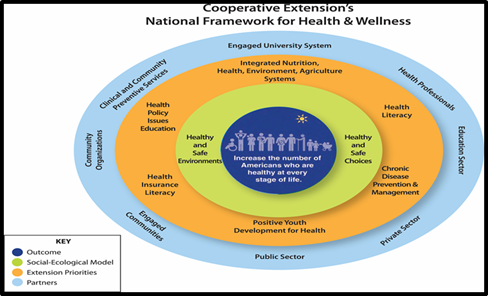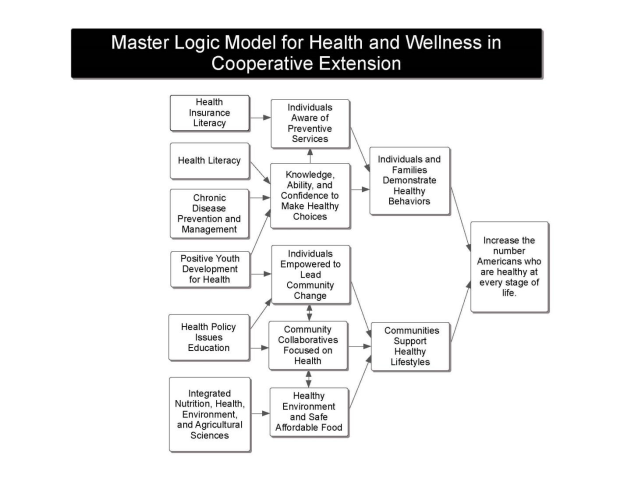 |
June 2015
|
June 2015 // Volume 53 // Number 3 // Tools of the Trade // v53-3tt1
Strategic Directions for Extension Health and Wellness Programs
Abstract
The new Cooperative Extension National Framework for Health and Wellness is a tool to help Extension systematically address the programmatic area of health and wellness at the individual, community, environmental, and policy levels. Key strategies of the framework tool are provided and suggestions for ways that Extension can use this framework tool to respond to the needs are proposed.
Does your educational programming meet needs of those you serve AND position Extension as a problem solver for issues affecting the nation's triple bottom line—financial, environmental, and social? One opportunity to do both is to use the new Cooperative Extension National Framework for Health and Wellness.
Why Health and Wellness?
Until 2010, the United States did not have a comprehensive policy strategy designed to prevent costly health problems (Koh & Sebelius, 2010). With passage of the Affordable Care Act, establishing the National Prevention Council, the U.S. began to "ensure the health, well-being and resilience of the American people." The Council released a strategic direction document and accompanying action plan with a vision, goal, priorities, and recommendations. The two documents are available at: http://www.surgeongeneral.gov/initiatives/prevention/strategy/report.pdf and http://www.surgeongeneral.gov/initiatives/prevention/2012-npc-action-plan.pdf.
The central goal of the strategy is to increase the number of Americans who are healthy at every stage of life. The document includes four foundational strategic directions intended as a basis for developing a prevention-oriented population of youths and adults:
Healthy and Safe Community Environments: Creating, sustaining, and recognizing communities that promote health and wellness through prevention.
Clinical and Community Preventive Services: Ensuring that prevention-focused health care and community prevention efforts are available, integrated, and mutually reinforcing.
Empowered People: Supporting people in making healthy choices.
Elimination of Health Disparities: Eliminating disparities and improving the quality of life for all Americans (National Prevention Strategy, 2011).
Included in the Council's document is a commitment to encourage partners to identify opportunities to act on prevention and health. These strategic directions can be addressed through education focused on individuals and families, communities, professionals, and/or policy makers. The nationwide Cooperative Extension system is uniquely positioned to be a strategic partner. With its network and expertise, Extension can address health and influence the social, economic and environmental determinates of healthy people across the life span.
How Can Extension Respond to This Health and Wellness Emphasis?
In 2012, the Extension Committee on Policy established a Health Task Force charged with identifying priorities for health programming, outcome indicators, and potential partners. The Task Force studied seven national trends, shown below, as a basis for setting priorities. For more information you can use in understanding how trends might impact your programming, see the report located at: https://www.aplu.org/document.doc?id=5134.
- Public Health Policy Shifts
- Health Conditions
- Health Disparities
- Economic Conditions
- Population Changes
- Technology
- Health Literacy
The Task Force also conducted a strategic analysis of strengths and weaknesses of Extension with an emphasis on health programming. That analysis, combined with a review of health priorities across the nation and within Extension, led the Task Force to choose the Council's National Prevention Strategy and the Action Plan as a foundation for the new Cooperative Extension's National Framework for Health and Wellness approved by ECOP in March 2014. As the Task Force reported,
By aligning Cooperative Extension with the National Prevention Strategy, we accomplish a mutually beneficial engagement of both public and private partners and . . . a national strategic direction that can both increase awareness of the value of prevention across multiple sectors and further support a comprehensive approach to preventing illness and disease by promoting health and wellness. (p 4)
The Framework uses a social ecological model (Mcleroy, Bibeau, Steckler, & Glanz, 1988; Brofenbrenner, 2000) to present the outcome, goal, environments, priorities, and partnerships. This model considers the complex interplay between individual, community, and societal factors. The model acknowledges an individual's attitudes, beliefs, behaviors, and choices. The community and societal factors include both the settings in which people live and work, as well as the social and cultural norms such as economics, educational and social policies, and inequalities.
The socio-ecological aspect of health is included in the model's first ring surrounding the common goal in the center as shown in Figure 1. In this ring, are two focus areas: "healthy and safe choices" and "healthy and safe environments." You can approach each separately or through the interplay between the two. The USDA Food and Nutrition Service includes the socioecologic model in their new guidance for SNAP-Ed funding.
Figure1.
Cooperative Extension's National Framework for Health and Wellness
The ECOP Health Task Force identified six priorities shown in the model's second ring. You can address priorities individually or in combination with other priorities, and one or both of the two focus areas to meet the needs of the people and communities you serve. The priorities are:
- Integrated Nutrition, Health, Environment, Agriculture Systems
- Health Literacy
- Chronic Disease Prevention and Management
- Positive Youth Development
- Health Insurance Literacy
- Health Policies Issues Education
The Task Force created the beginning of a logic model shown in Figure 2 below. You are encouraged to customize this logic model for your Extension health and wellness program planning, evaluation, and reporting and for communicating with potential partners.
Figure 2.
Master Logic Model for Health and Wellness in Cooperative Extension

How Are You Responding to the Extension Framework for Health and Wellness?
ECOP approved the report, the framework, and recommendations for changes that enable this model to be put into effect in the coming years across the Cooperative Extension System. Meanwhile, local, regional, and state programming units can begin to use the two tools—the framework and logic model—to develop or modify programming in research and Extension.
In Responding to "Health Care Reform: Mobilizing Extension," Braun (2012) challenged Extension to respond to opportunities for educational programming produced by health reform legislation. With ECOP's action, we now have a document that provides strategic directions for Extension health and wellness programs.
With these two new tools, you should be able to reflect, then act, on opportunities to help your communities achieve and maintain healthy and safe environments and individuals make healthy and safe personal choices. As we move into the second century of Extension, we may be able to do for the health of the people of this nation what our predecessors did for its agriculture. And in doing so, you will both strategically address needs of those you serve and help to strategically position Extension as a partner in achieving the nation's triple bottom line.
Acknowledgement
The authors acknowledge the contribution of the other members of the Task Force who met the ECOP goals and produced the approved report:. Karen Bruns, Linda Cronk, Linda Kirk Fox, Sonja Koukel, Suzanne Le Menestrel, Lily Monroe Lord, Cindy Reeves (Co-Chair), Roger Rennekamp, Carol Rice, Javiette Samuel, Ann Vail, and Tamara Warren. We also applaud ECOP leaders for adopting and acting on the report.
References
Braun, B. (2012, October). Responding to health care reform: Mobilizing Extension. Journal of Extension [On-line] 50(5) Article 5COM1. Available at: http://www.joe.org/joe/2012october/comm1.php
Bronfenbrenner, U. (2000). Ecological models of human development. In M. Gauvain & M. Cole (Eds.), Readings on the development of children (pp. 37-43). New York, NY: Worth Publishers.
Cooperative Extension's National Framework for Health and Wellness. (2014, March). Retrieved from https://www.aplu.org/document.doc?id=5134.
Koh, H., & Sebelius, K. (2010, September). Promoting prevention through the Affordable Care Act. New England Journal of Medicine, 363. 1296-1299.
McLeroy, K, Bibeau, D., Steckler, A., & Glanz, K. (1988). An ecological perspective on health promotion programs. Health Education Quarterly, 15, 351-377.
U. S. Department of Health and Human Services. (2010). In HHS Strategic Plan Appendix B-2: Performance Measures (Detail Report). Retrieved from: http://www.hhs.gov/secretary/about/appendixb2.html
U.S. Health and Human Services. (2011). National Prevention Strategy Report. Retrieved from: http://www.surgeongeneral.gov/initiatives/prevention/strategy/report.pdf




